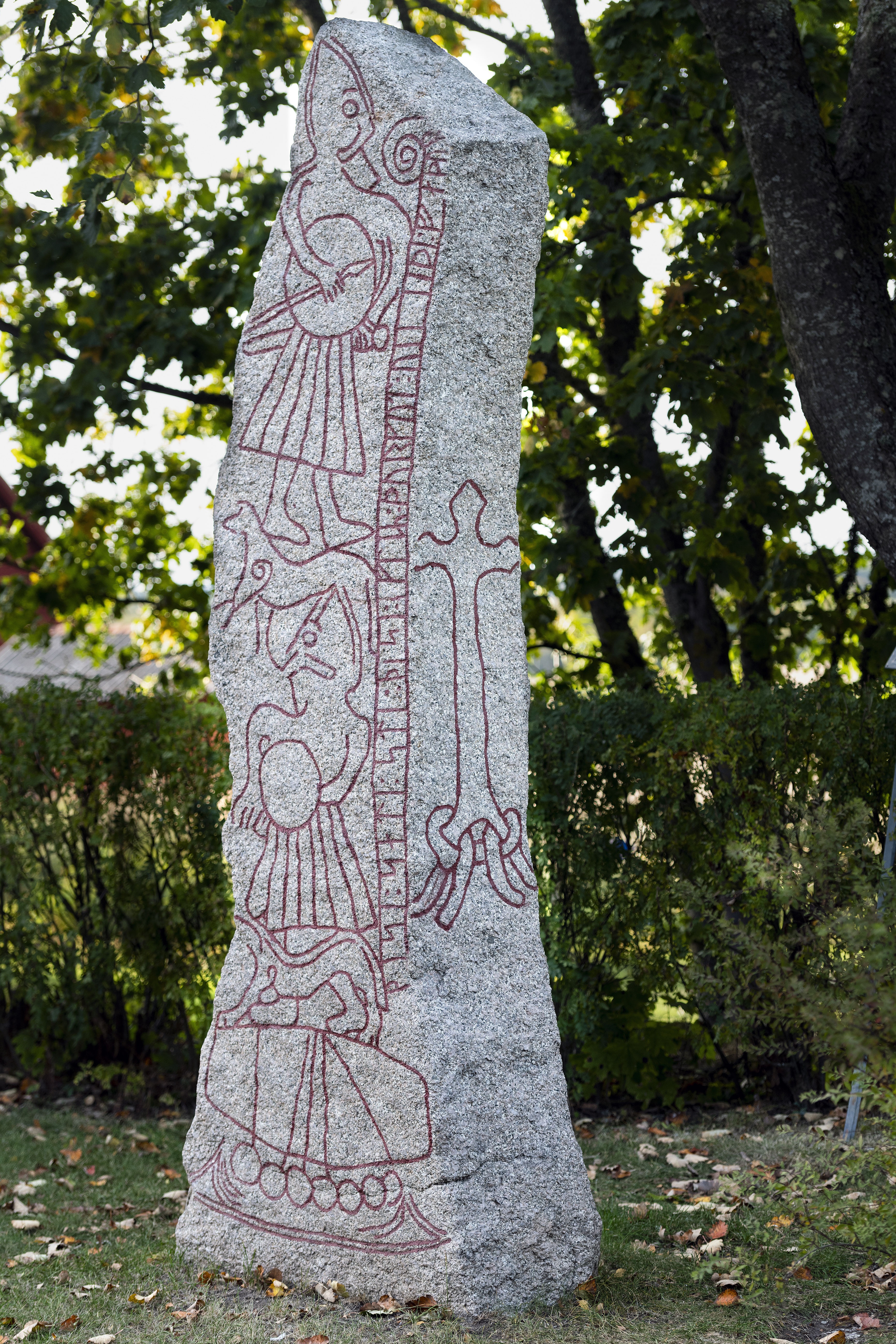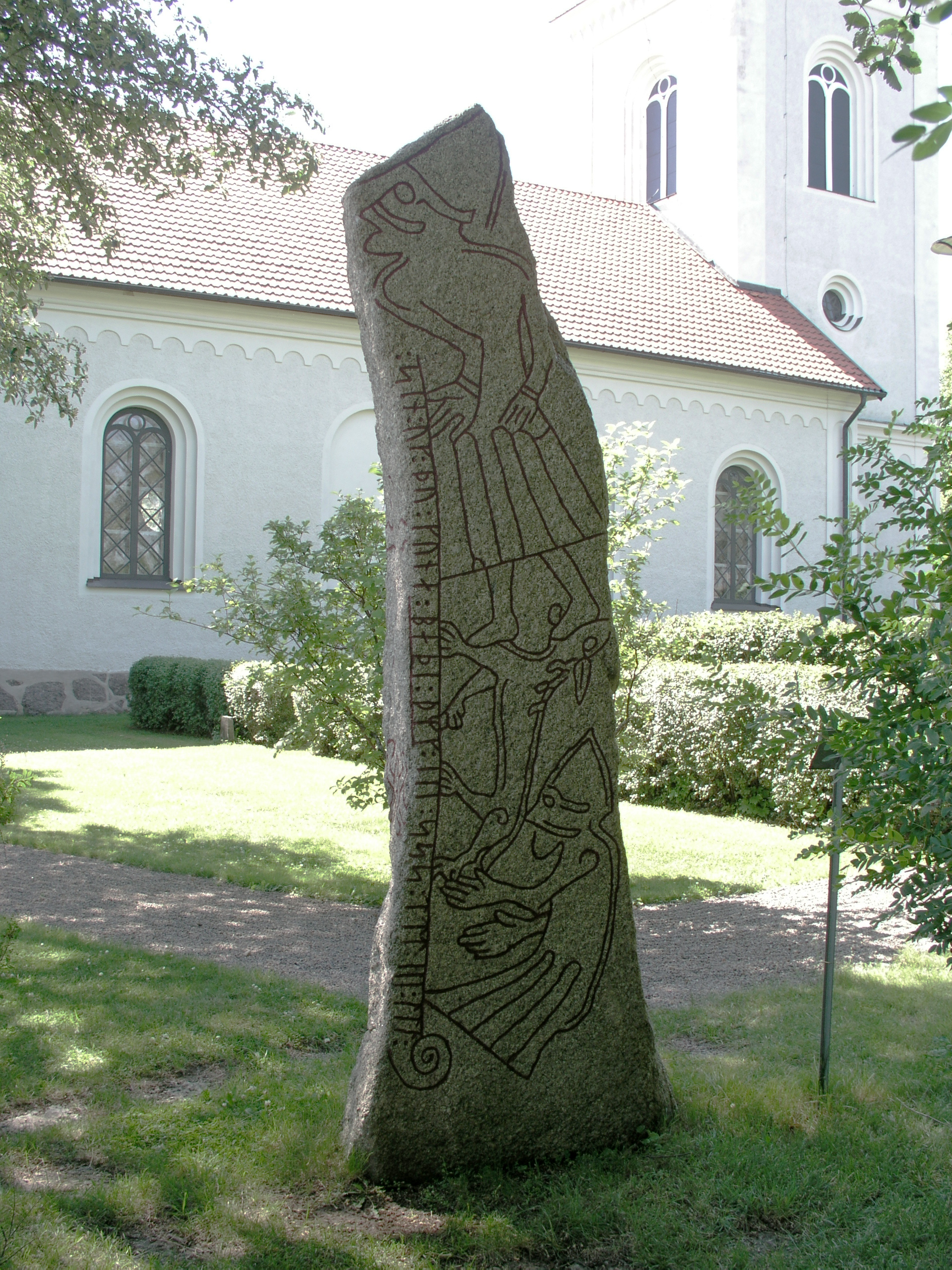Ledberg Stone on:
[Wikipedia]
[Google]
[Amazon]
The Ledberg stone, designated as Ög 181 under
 The Ledberg stone is a partially surviving
The Ledberg stone is a partially surviving
 The runic inscription of the Ledberg stone is carved in the
The runic inscription of the Ledberg stone is carved in the
Rundata
The Scandinavian Runic-text Data Base ( sv, Samnordisk runtextdatabas) is a project involving the creation and maintenance of a database of runic inscriptions. The project's goal is to comprehensively catalog runestones in a machine-readable way f ...
, is an image-stone
A picture stone, image stone or figure stone is an ornate slab of stone, usually limestone, which was raised in Germanic Iron Age or Viking Age Scandinavia, and in the greatest number on Gotland.The article ''Bildstenar'' in ''Nationalencyklopedi ...
and runestone
A runestone is typically a raised stone with a runic inscription, but the term can also be applied to inscriptions on boulders and on bedrock. The tradition began in the 4th century and lasted into the 12th century, but most of the runestones da ...
located in Östergötland, Sweden
Sweden, formally the Kingdom of Sweden,The United Nations Group of Experts on Geographical Names states that the country's formal name is the Kingdom of SwedenUNGEGN World Geographical Names, Sweden./ref> is a Nordic country located on ...
.
Description
 The Ledberg stone is a partially surviving
The Ledberg stone is a partially surviving runestone
A runestone is typically a raised stone with a runic inscription, but the term can also be applied to inscriptions on boulders and on bedrock. The tradition began in the 4th century and lasted into the 12th century, but most of the runestones da ...
, similar to Thorwald's Cross. It features a figure with his foot at the mouth of a four-legged beast, below which lies a legless, helmeted man, with his arms in a prostrate position.Jansson, Sven B. (1987). ''Runes in Sweden''. Stockholm, Gidlund. . p. 152. This is thought to be a depiction of Odin
Odin (; from non, Óðinn, ) is a widely revered Æsir, god in Germanic paganism. Norse mythology, the source of most surviving information about him, associates him with wisdom, healing, death, royalty, the gallows, knowledge, war, battle, v ...
being devoured by the wolf Fenrir
Fenrir (Old Norse: ; "fen-dweller")Orchard (1997:42). or Fenrisúlfr (O.N.: ; "Fenrir's wolf", often translated "Fenris-wolf"),Simek (2007:81). also referred to as Hróðvitnir (O.N.: ; "fame-wolf")Simek (2007:160). and Vánagandr (O.N.: ; " ...
at Ragnarök, the final battle in Norse mythology
Norse, Nordic, or Scandinavian mythology is the body of myths belonging to the North Germanic peoples, stemming from Old Norse religion and continuing after the Christianization of Scandinavia, and into the Nordic folklore of the modern period ...
, in which several gods meet their death. The battle and death of Odin are described in the poem ''Völuspá
''Vǫluspá'' (also ''Völuspá'', ''Vǫlospá'' or ''Vǫluspǫ́''; Old Norse: 'Prophecy of the völva, a seeress'; reconstructed Old Norse: ) is the best known poem of the ''Poetic Edda''. It tells the story of the creation of the world and ...
'' from the ''Poetic Edda
The ''Poetic Edda'' is the modern name for an untitled collection of Old Norse anonymous narrative poems, which is distinct from the ''Prose Edda'' written by Snorri Sturluson. Several versions exist, all primarily of text from the Icelandic me ...
''.
Some scholars, however, believe that the images of the Ledberg stone depict the final story of either Þorgautr or Gunna, who are memorialized in the runic inscription. If the images are followed in the same order as the runes are written, they seem to create a chronological account. The first image is of a ship; this depicts a journey abroad. Next, there is a figure walking to the left, carrying what is most likely a shield, in preparation for departure. In the third image, the figure is carrying weapons and a shield to the right, probably marching to battle. At the top of the second side of the stone, the figure's foot is being bitten by a wolf and finally, we see the figure legless with arms sprawled, likely lying dead on the battlefield. Wolves were often used in Viking art
Viking art, also known commonly as Norse art, is a term widely accepted for the art of Scandinavian Norsemen and Viking settlements further afield—particularly in the British Isles and Iceland—during the Viking Age of the 8th-11th centuries ...
and poetry to signify combat, so it is thought to be unlikely that the figure fell in battle due to wounds caused by a wolf.
The warrior figures have shields, one carries a spear, and all have moustaches and beards, except for the Odin figure. The helmets are conical and similar in shape to those shown on the Bayeux Tapestry.
Inscription
 The runic inscription of the Ledberg stone is carved in the
The runic inscription of the Ledberg stone is carved in the Younger futhark
The Younger Futhark, also called Scandinavian runes, is a runic alphabet and a reduced form of the Elder Futhark, with only 16 characters, in use from about the 9th century, after a "transitional period" during the 7th and 8th centuries.
The r ...
, and is dated to the 11th century. It reads:
:§A ᛒᛁᛋᛁ ᛬ ᛋᛅᛏᛁ ᛬ ᛋᛏᛁ ᛬ ᚦᛁᛋᛁ ᛬ ᛁᚠᛏᛁᛦ ᛬ ᚦᚢᚱᚴᚢᛏ ᛬ ᚢ----ᚦᛁ ᛬ ᚠᛅᚦᚢᚱ
::(b)isi · sati : sti : þisi : iftiʀ : þurkut : u----þi : faþur
:§B ᛬ ᛋᛁᚾ ᛬ ᚢᚴ ᛬ ᚦᚢ ᛬ ᚴᚢᚾᛅ ᛬ ᛒᛅᚦᛁ ᛬
::: sin : uk : þu : kuna : baþi :
Translated into English:
: §A Bisi placed this stone in memory of Þorgautr … his father. §B And Gunna, both.
Charm
The final part of the B-side contains a rhyming charm or spell (galdr
A (plural ') or (plural ) refers to a spell or incantation in Old Norse and Old English respectively; these were usually performed in combination with certain rites.The article ''Galder'' in ''Nationalencyklopedin'' (1992)
Etymology
non, g ...
), which reads:
:ᚦᛘᚴ ᛬ ᛁᛁᛁ ᛬ ᛋᛋᛋ ᛬ ᛏᛏᛏ ᛬ ᛁᛁᛁ ᛬ ᛚᛚᛚ ᛬
:þmk : iii : sss : ttt : iii : lll :
which is to be read (in normalized Old Icelandic spelling):
:''þistill, mistill, kistill''
The three words mean ''thistle
Thistle is the common name of a group of flowering plants characterised by leaves with sharp prickles on the margins, mostly in the family Asteraceae. Prickles can also occur all over the planton the stem and on the flat parts of the leaves ...
'', ''mistletoe
Mistletoe is the common name for obligate hemiparasitic plants in the order Santalales. They are attached to their host tree or shrub by a structure called the haustorium, through which they extract water and nutrients from the host plant.
...
'' and ''casket
A casket jewelry box is a container that is usually smaller than a chest, and in the past were typically decorated. Whereas cremation jewelry is a small container, usually in the shape of a pendant or bracelet, to hold a small amount of ashes.
...
'' respectively. This type of charm is found on a few other inscriptions, among them the runic inscription on the Gørlev runestone, DR 239, from Sjælland
Zealand ( da, Sjælland ) at 7,031 km2 is the largest and most populous island in Denmark proper (thus excluding Greenland and Disko Island, which are larger in size). Zealand had a population of 2,319,705 on 1 January 2020.
It is the 1 ...
, Denmark
)
, song = ( en, "King Christian stood by the lofty mast")
, song_type = National and royal anthem
, image_map = EU-Denmark.svg
, map_caption =
, subdivision_type = Sovereign state
, subdivision_name = Danish Realm, Kingdom of Denmark
...
. It has been noted that Pliny the Elder
Gaius Plinius Secundus (AD 23/2479), called Pliny the Elder (), was a Roman author, naturalist and natural philosopher, and naval and army commander of the early Roman Empire, and a friend of the emperor Vespasian. He wrote the encyclopedic '' ...
recorded that the Celts gathered mistletoe as a cure for infertility, and that singing a charm over herbs increased their power, which may have led to the ''þistill mistill kistill'' combination.
Of the personal names in the inscription, Þorgautr contains as a name element the Norse god Thor
Thor (; from non, Þórr ) is a prominent god in Germanic paganism. In Norse mythology, he is a hammer-wielding god associated with lightning, thunder, storms, sacred groves and trees, strength, the protection of humankind, hallowing, an ...
and translates as "Thor-Goth."
See also
*Runic magic
There is some evidence that, in addition to being a writing system, runes historically served purposes of magic. This is the case from the earliest epigraphic evidence of the Roman to the Germanic Iron Age, with non-linguistic inscriptions and th ...
References
{{coord, 58, 26, 32, N, 15, 26, 50, E, region:SE_type:landmark_source:kolossus-svwiki, display=title Picture stones Runestones in Östergötland 11th-century inscriptions Odin in art